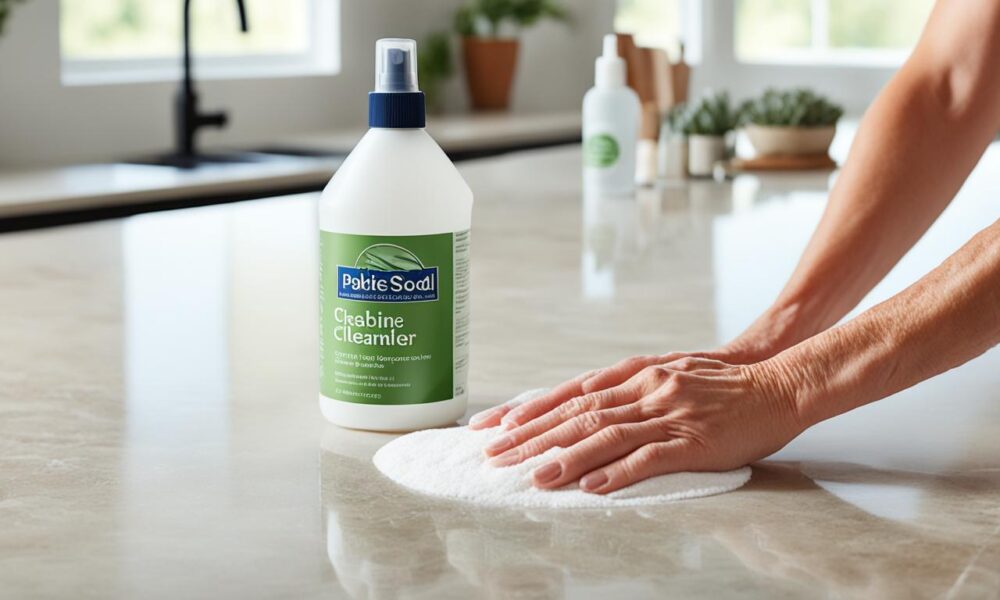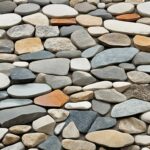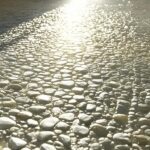Natural Stone Care: Essential Tips for Maintenance
Natural stone is a top choice for flooring and countertops in many homes across the U.S. Its beauty and strength make it a favorite. But, to keep your stone looking great, you need to know how to care for it. Follow these tips to protect your stone and enjoy its beauty for years.
First, learn about your stone’s unique needs. Whether it’s marble, granite, travertine, or limestone, each stone has its own care requirements. Clean it regularly with the right products to avoid dirt buildup. Sealing your stone can also protect it from stains and spills.
Don’t forget to act fast on spills or stains. Quick action can stop liquids from damaging your stone. For hard stains, you might need special cleaners. It’s also key to protect your stone from scratches, etching, and heat damage to keep it looking good.
Key Takeaways
- Understand the specific care requirements for your natural stone type
- Clean regularly using stone-safe products to prevent buildup
- Seal stone surfaces as recommended to protect against stains and spills
- Address spills and stains promptly to avoid permanent damage
- Protect natural stone from scratches, etching, and heat damage
- Consider professional stone restoration for deep cleaning or repair needs
Understanding Your Natural Stone
Natural stone is a beautiful and durable material that can make any space look great. To keep your natural stone looking new, it’s key to know what makes each stone special. Learning about your stone’s unique traits helps keep it looking good for many years.
Identifying Your Stone Type
Natural stone comes in three main types: sedimentary, metamorphic, and igneous. Sedimentary stones, like limestone and travertine, form from compressed sediments. Metamorphic stones, such as marble, change from other rocks under heat and pressure. Igneous stones, like granite, come from cooled magma or lava.
Stones are also classified as calcareous or siliceous. Calcareous stones, including marble and limestone, are mostly calcium carbonate and react to acidic solutions. Siliceous stones, like granite and quartzite, are mostly silicates and resist acids better. But, even siliceous stones can have minerals that react to acids.
Characteristics of Different Stone Types
Each natural stone has its own set of traits that affect its durability, porosity, and resistance to stains. Knowing these traits helps you pick the right cleaning products and maintenance techniques for your stone.
- Marble: Marble is known for its elegant look and is often used for countertops and decorative pieces. But, it’s a softer stone that scratches and etches easily with acidic substances.
- Granite: Granite is tough and perfect for busy areas and kitchen counters. It’s less porous than marble and stains less, but it needs sealing to stay protected.
- Limestone: Limestone has a soft texture and neutral colors, adding warmth to any space. It’s softer and more porous than granite, so it stains and etches easily.
- Travertine: Travertine is a type of limestone known for its unique holes and texture. It’s used for flooring and walls. Like other calcareous stones, it’s sensitive to acids and needs sealing to prevent stains.
“The key to maintaining the beauty and longevity of your natural stone is to understand its unique properties and adapt your care routine accordingly.” – Sarah Johnson, Natural Stone Expert
By identifying your stone type and understanding its traits, you can create a care plan that keeps your natural stone looking great for years.
Basic Cleaning Techniques for Natural Stone
Keeping your natural stone surfaces looking great needs a gentle and consistent cleaning routine. By cleaning regularly with the right products, your stone will stay beautiful for many years. This is true for granite, marble, travertine, or any other stone type. These simple cleaning tips will keep your stone’s natural beauty shining.
Daily Cleaning Routines
For the best look, a daily cleaning routine is key. Wipe down your stone surfaces daily to stop dirt and grime from building up. Use a soft cloth or a mop with warm water for this. In places like bathrooms, a squeegee can help keep soap scum away.
Choosing the Right Cleaning Products
Choosing the right cleaners for cleaning natural stone is important. Go for pH-neutral cleaners or mild dish soap. These cleaners clean well without damaging the stone. Always rinse with clean water after cleaning to avoid residue damage.
| Stone Type | Recommended Cleaning Products |
|---|---|
| Granite | pH-neutral cleaner, mild dish soap |
| Marble | Mild, non-abrasive cleaner specifically formulated for marble |
| Travertine | pH-neutral cleaner, mild dish soap |
| Limestone | pH-neutral cleaner, stone soap |
Avoiding Harsh Chemicals and Abrasives
It’s crucial to avoid harsh chemicals and abrasive cleaners for natural stone. These can etch, scratch, or dull the stone. Don’t use vinegar, lemon juice, or bleach. Instead, use recommended pH-neutral cleaners and soft cloths or mops.
Always test a new cleaning product on a small, inconspicuous area of the stone before applying it to the entire surface to ensure it doesn’t cause any adverse reactions.
By following these simple cleaning tips and using the right products, your stone surfaces will stay beautiful. Regular cleaning with pH-neutral cleaners and avoiding harsh chemicals will keep your stone looking great for years.
Dealing with Spills and Stains
Accidents can happen even with the best care for natural stone surfaces. When spills and stains occur, acting fast is crucial to avoid permanent damage. Knowing the stain type and the right cleaning method is key to removing stains from natural stone.
Acting Quickly to Prevent Staining
Time is crucial when a spill happens on your natural stone. Blot the spill with a clean, dry cloth or paper towel to soak up as much liquid as you can. Don’t wipe the area to avoid spreading the spill and causing more damage. After blotting, clean the area with water and a mild, pH-neutral soap to stop the stain from setting.
Identifying Different Types of Stains
It’s important to know the type of stain on your natural stone to remove it effectively. Common types of stains include:
- Oil-based stains: Grease, cooking oil, cosmetics, and tar
- Organic stains: Coffee, tea, wine, fruit, and food dyes
- Biological stains: Mold, mildew, and algae
- Metal stains: Iron, rust, copper, and bronze
- Ink stains: Magic markers, pens, and ink
Once you know the stain type, you can pick the best cleaning method to remove it.
Using Poultices for Stubborn Stains
For tough stains, a poultice might be needed to remove the stain from the stone. A poultice is a paste made from a cleaning agent and an absorbent material like kaolin clay, diatomaceous earth, or baking soda.
| Stain Type | Poultice Ingredients |
|---|---|
| Oil-based | Baking soda and water, or mineral spirits |
| Organic | Hydrogen peroxide and a powdered absorbent material |
| Biological | Bleach and water |
| Metal | Commercial rust remover or a poultice with diatomaceous earth and mineral spirits |
| Ink | Bleach or hydrogen peroxide for light-colored stones; lacquer thinner or acetone for dark stones |
To use a poultice, mix the ingredients into a thick paste and spread it over the stained area, going beyond the stain’s edges. Cover it with plastic wrap and let it dry for 24-48 hours. Then, remove the plastic and poultice, rinse with clean water. If needed, repeat up to five times for tough stains.
Remember, when dealing with natural stone stains, patience and persistence are key. With the right cleaning methods and products, most stains can be successfully removed, restoring your stone’s natural beauty.
Sealing Your Natural Stone
Sealing your natural stone surfaces is key to keeping them looking great and lasting long. A sealer acts like a shield, keeping the stone safe from stains, etching, and daily wear. This step not only makes the stone look better but also helps it last longer, keeping your investment looking good for years.
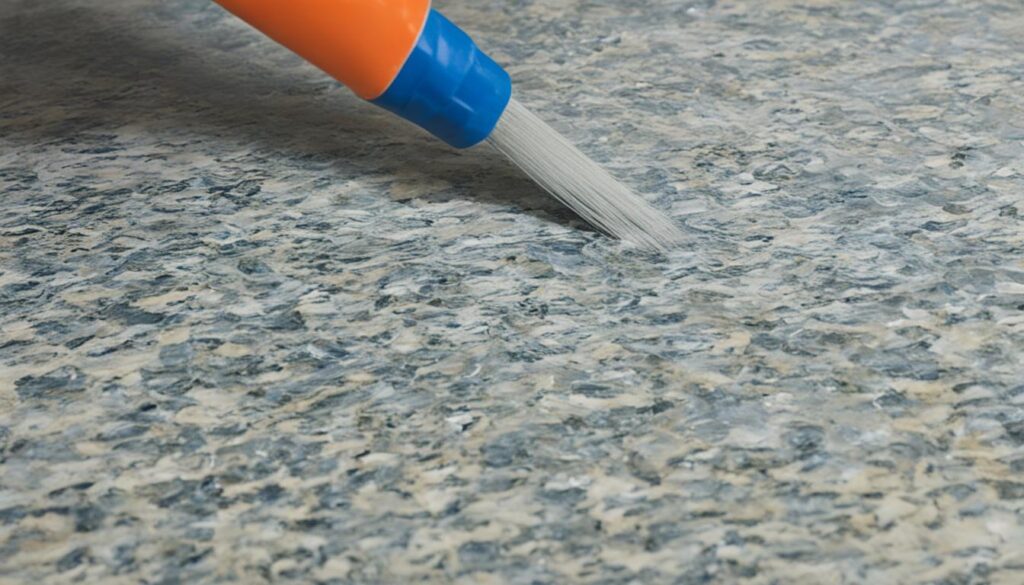
Benefits of Sealing Stone Surfaces
Sealing your natural stone has many benefits, including:
- Protection against stains and etching from things like wine, coffee, and citrus
- Easy cleaning because spills and dirt don’t easily get into the stone
- Enhanced color and texture, depending on the sealer used
- Longer-lasting and more durable, especially in busy areas
Types of Sealers Available
There are two main types of sealers for natural stone: impregnating sealers and stone enhancers.
- Impregnating sealers go into the stone’s pores, stopping stains without changing how the stone looks. They last a long time and don’t fade in sunlight.
- Stone enhancers can make the stone darker and richer while still protecting it. They’re often used on certain types of stone to give them a wet look.
When picking a sealer, think about the stone type, where it’s located, and the look you want. For example, marble does well with impregnating sealers and ones that resist acid. Granite is good with impregnating sealers and certain other types of sealers.
How Often to Seal Your Stone
How often you need to seal your stone depends on things like the stone type, how porous it is, and how much traffic it gets. Generally, seal your stone every one to three years. But some stones might need sealing more often:
| Stone Type | Porosity | Recommended Sealing Frequency |
|---|---|---|
| Granite | Low | Every 3-5 years |
| Marble | Medium | Every 1-3 years |
| Limestone | High | Every 6-12 months |
| Travertine | High | Every 6-12 months |
To see if your stone needs resealing, do a water drop test. If the water changes the stone’s color or soaks in quickly, it’s time to reapply a sealer. Always clean your stone well before sealing to make sure the sealer goes on evenly and works best.
A study by the National Center for Preservation Technology and Training (NCPTT) showed that preparing natural stone surfaces right can make sealants absorb up to 40% better.
By sealing your natural stone regularly and using top-quality sealers like Granite Gold® Sealer, you can keep your stone looking great and lasting long.
Protecting Natural Stone from Damage
Natural stone is tough and lasts a long time, but it needs the right care to stay looking great. Keeping it safe from scratches, etching, and other damage is key. This helps it stay in top shape for many years.
Using Coasters, Trivets, and Mats
Using coasters, trivets, and mats is an easy way to protect your natural stone. Put coasters under glasses with acidic drinks like citrus or alcohol to stop etching and staining. For hot dishes, use trivets or mats to prevent thermal shock. This can cause cracks or discoloration.
In busy areas, think about using non-slip mats or rugs. They help keep sand, dirt, and grit from scratching the stone. This simple action can greatly reduce wear and tear on your stone floors and countertops.
Avoiding Scratches and Etching
Scratches and etching are common issues with natural stone. While most stones resist scratches and burns, they’re not completely safe. Be careful with sharp objects or abrasive materials near your stone to avoid scratches.
Etching happens when acidic things touch stones like marble and limestone. These acids can break down the stone’s calcium carbonate, leaving dull spots or rough areas. To stop etching, always use coasters and clean spills quickly. This is especially true for acidic foods and drinks like lemon juice, vinegar, or wine.
| Substance | Potential Damage | Prevention Method |
|---|---|---|
| Acidic beverages (citrus juices, alcohol) | Etching, staining | Use coasters |
| Hot dishes | Thermal shock, cracks, discoloration | Use trivets or mats |
| Sand, dirt, grit | Scratches, wear and tear | Use non-slip mats or rugs |
| Acidic foods (lemon juice, vinegar) | Etching, dull spots | Clean up spills promptly, use coasters |
By following these simple steps and protecting your natural stone from scratches and etching, you can keep it looking beautiful and lasting for years.
Maintenance Tips for Specific Stone Types
All natural stone surfaces need regular care and maintenance. Each stone type has its own needs. Knowing what your stone needs is key to keeping it looking great and lasting long.
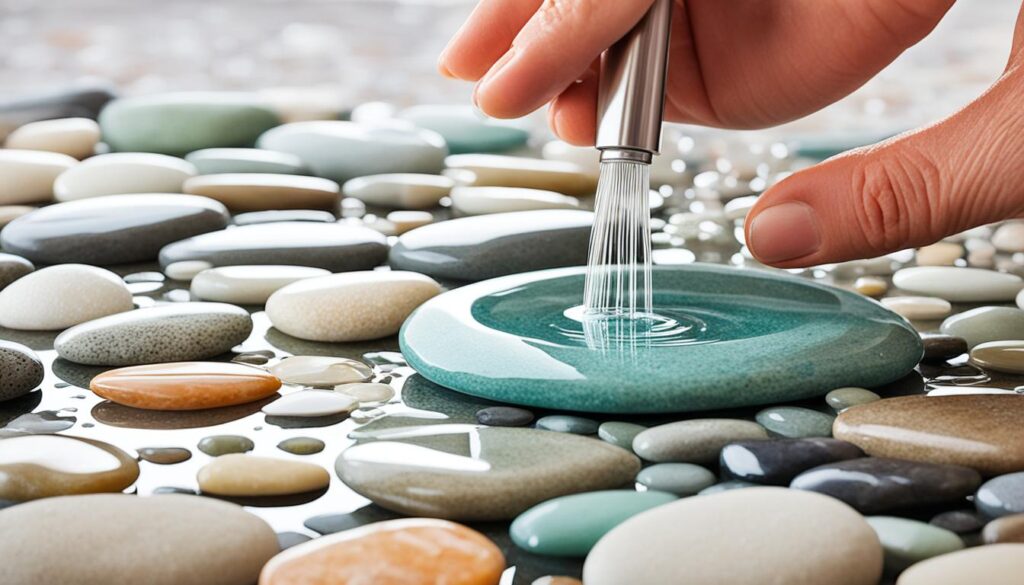
Marble Care and Maintenance
Marble is a classic and beautiful stone but it’s also very delicate. To keep it shining, you must take good care of it. Seal it once a year to stop stains and etching, as marble reacts badly to acidic things.
Clean spills right away with a cleaner that’s pH-neutral and a soft cloth. Don’t use rough stuff or harsh chemicals, as they can scratch or dull the marble.
Granite Upkeep and Cleaning
Granite is loved for its toughness and resistance to stains and scratches. But, it still needs regular care. Seal it once a year to keep it stain and moisture resistant.
Clean it every day with a microfiber cloth and a cleaner made for granite. Always wipe up spills fast to avoid stains.
Caring for Travertine and Limestone
Travertine and limestone add warmth and texture to any space. But, they’re very porous and need careful upkeep. Seal them every six to twelve months to stop stains and etching.
Use a cleaner that’s pH-neutral and made for these stones, and skip harsh or acidic stuff. Clean spills right away and dry the area well to stop water spots or stains.
| Stone Type | Sealing Frequency | Cleaning Products | Stain Removal |
|---|---|---|---|
| Marble | Annual | pH-neutral cleaner | Clean spills immediately |
| Granite | Annual | Granite-safe cleaner | Wipe up spills promptly |
| Travertine | Every 6-12 months | pH-neutral cleaner | Clean spills immediately |
| Limestone | Every 6-12 months | pH-neutral cleaner | Clean spills immediately |
Follow these tips for each stone type to keep your natural stone looking great and lasting long. Remember, taking good care of your marble, granite, travertine, or limestone is key to keeping their beauty.
Addressing Etching and Scratches
Even with good care, your natural stone surfaces can get etched or scratched over time. Etching happens when acidic things touch the stone, making dull spots or rough areas. Scratches come from rough materials or sharp things.
If you see light etching, you might fix it with a special polishing powder for your stone. But deep etching might need a pro to fix it and make it smooth again.
For shallow scratches, you can try buffing with a fine steel wool pad. But test it first on a small, hidden spot. Deep scratches usually need a pro to polish and hone the stone back to its smooth state.
When in doubt, it’s always best to consult with a professional natural stone restoration company to assess the damage and determine the most appropriate course of action.
To stop etching and scratches, follow these tips:
- Use coasters, trivets, and placemats to protect against acidic substances and sharp objects
- Clean up spills quickly to lower the chance of etching
- Avoid sliding heavy things across the stone to prevent scratches
- Use cleaning products made for your stone type to avoid damage
| Damage Type | Characteristics | Restoration Options |
|---|---|---|
| Light Etching | Dull spots, slight roughness | Polishing powder, professional restoration |
| Deep Etching | Rough patches, significant dullness | Professional natural stone restoration |
| Shallow Scratches | Superficial marks, minimal depth | Fine steel wool pad, professional polishing |
| Deep Scratches | Noticeable grooves, significant depth | Professional restoration and polishing |
Fixing etching and scratches quickly and preventing them can keep your natural stone looking great for a long time.
Professional Stone Restoration Services
Some natural stone maintenance tasks are best left to the pros. Experts in natural stone care have the skills and tools for tough problems like deep scratches or stains. They can work on stones like marble, granite, and others that need special care.
When to Call in the Professionals
If you see cracks or discoloration on your stone, call a pro. They can fix small problems before they get worse. If you’ve tried to clean a stain and it didn’t work, a pro can help.
Benefits of Professional Stone Care
Professional care can make your stone look new again. It protects against stains and damage. This is key for busy areas like kitchen counters.
With regular care and expert help, your stone can stay beautiful and last longer. This keeps your stone looking great and protects your investment.

